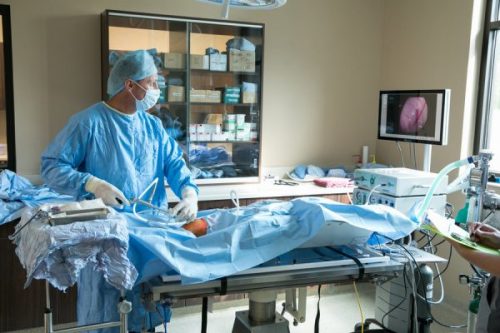
Veterinary Laparoscopy Offers Minimally Invasive Diagnostics & Surgical Options
Laparoscopic surgery is a state of the art, minimally invasive surgical technique that can be used for viewing and treating organs inside your pet’s abdomen. Our own Dr. Brad Petersen has a special interest and advanced training in performing surgeries of this kind, working on all laparoscopic cases personally to assure the maximum benefit to our patients. Petersen Pet Hospital is proud to offer exceptional care in this area to all current patients and veterinary referrals.
How Does Laparoscopy Work?
With laparoscopy, rigid endoscopes permit direct visual examination of your pet’s abdominal cavity without the need for a large surgical incision. This allows for more accurate diagnosis and treatment of various abdominal diseases and disorders.
It is a relatively safe technique for the patient, minimizing soft tissue trauma and allowing for faster and less painful recovery. Time spent under anesthesia can be reduced during these procedures as well, a benefit to seriously ill or senior pets.
Uses for Veterinary Laparoscopy
Laparoscopy was first used as a diagnostic tool, for viewing inside the abdominal cavity. Since that time, additional uses have been identified including exploratory surgeries, biopsy sample collection, and routine surgeries such as spays and preventive gastropexy.
This less invasive form of surgical procedure allows for shorter post-operative recovery times, reduced opportunity for infections, and less pain for our patients.
Common Laparoscopic Procedures
Gastropexy—This is a technique in which the stomach is permanently secured to the abdominal wall, preventing it from rotating abnormally. Gastric-dilatation and volvulus (GDV), often called bloat, is a life-threatening problem that occurs in large, deep-chested dogs. This procedure can be performed in dogs that are predisposed to GDV, to prevent the occurrence of this disease. This procedure is called prophylactic gastropexy.
Ovariohysterectomy—This is commonly referred to as a spay, and is a fast, simple surgical procedure. An ovariohysterectomy is when the ovaries and uterus are removed.
Laparoscopic diagnostic procedures—Common diagnostic procedures performed at our hospital include biopsies of organs or masses to test for a variety of conditions. Organs biopsied include the liver, pancreas, and kidney, as well as the intestines and bladder.
